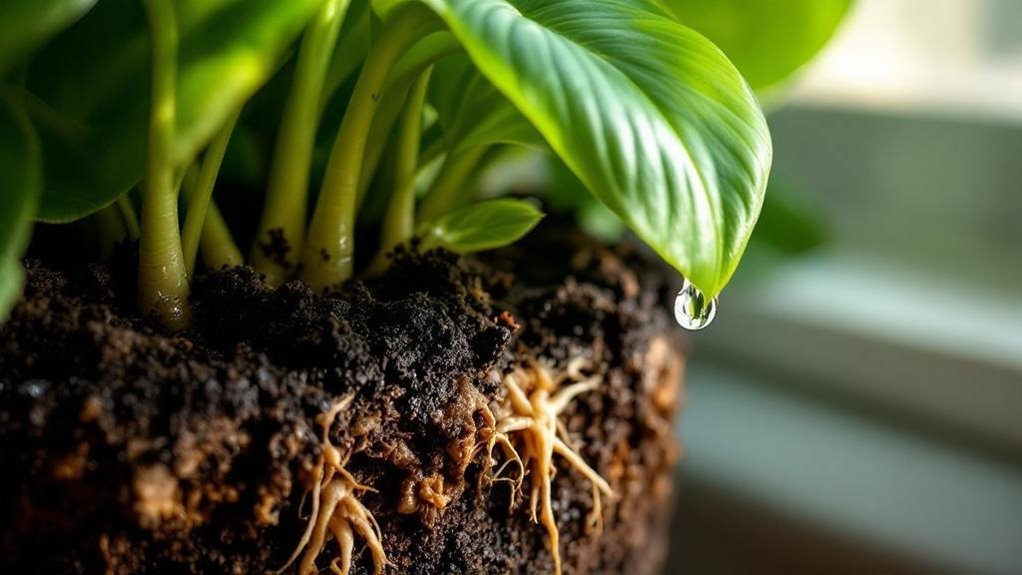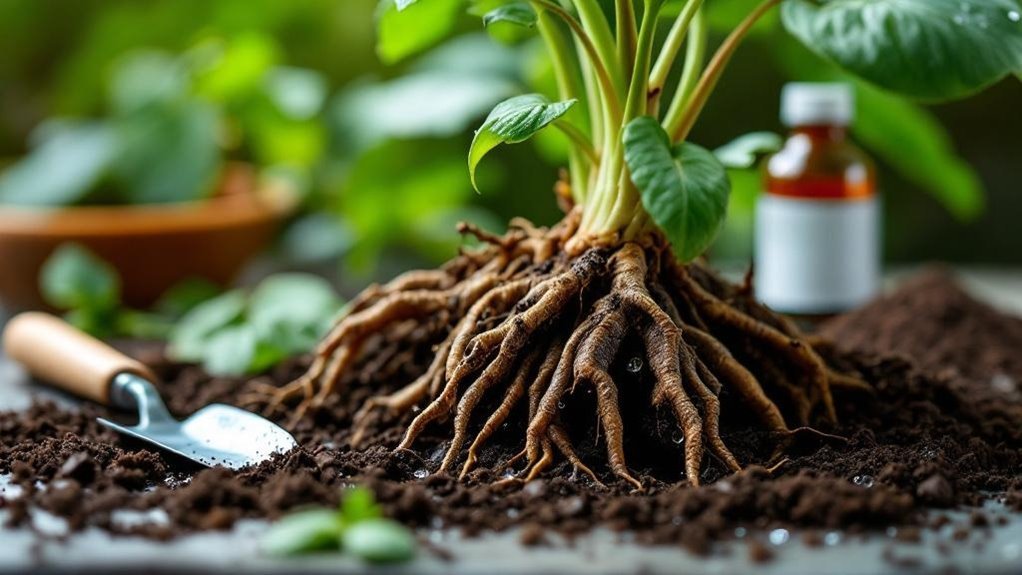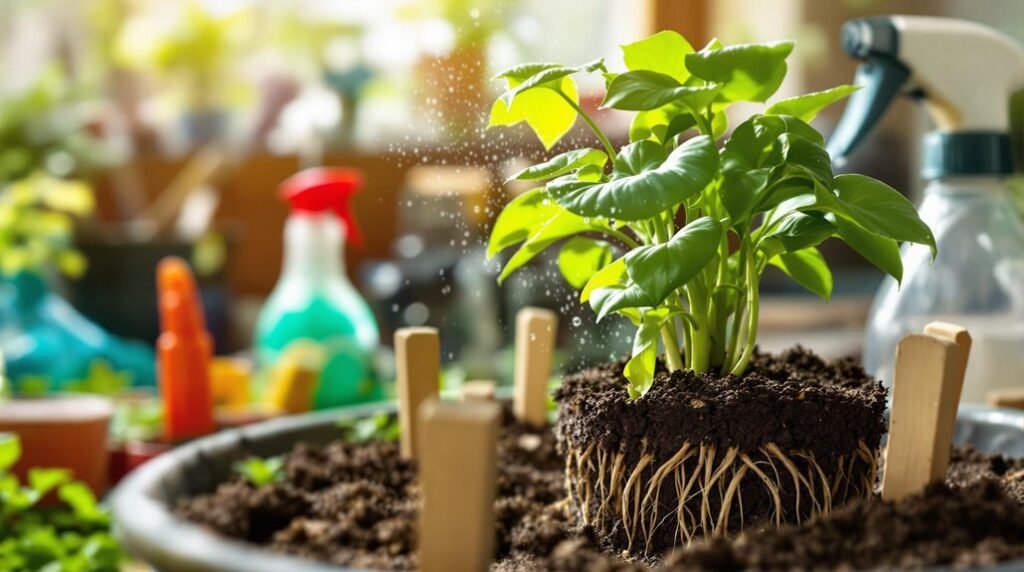If you’ve noticed your plants looking droopy or yellowing despite regular care, root rot might be the culprit. It sneaks in when roots stay too wet, causing decay that can quickly spread. You’ll want to act fast to stop the damage and save your plants. Understanding the early signs and knowing how to treat root rot properly can make all the difference in keeping your greenery thriving.
What Is Root Rot?
Root rot is a common plant disease caused by overwatering and poorly draining soil that encourages harmful fungi like Pythium and Phytophthora to grow.
These fungi thrive in waterlogged conditions where oxygen is scarce, which causes roots to decay and lose their ability to absorb nutrients.
When root rot sets in, you’ll notice signs of root rot above ground, such as wilting, yellowing leaves, and stunted growth—symptoms that can easily be mistaken for other problems.
To confirm root rot, you need to inspect the roots: healthy roots are white and firm, while roots affected by root rot turn brown or black, become mushy, and may smell foul.
Understanding these signs helps you catch root rot early and save your plants.
Common Causes of Root Rot
Overwatering is one of the most common reasons your plant may develop root rot, as excess water limits oxygen around the roots and encourages harmful fungi to flourish.
Overwatering reduces oxygen to roots and promotes harmful fungi growth, leading to root rot.
Poor drainage worsens this problem by trapping water, especially if your pot lacks drainage holes or contains dense soil that retains excess moisture. Fungi like Pythium and Phytophthora thrive in these saturated conditions, attacking your plant’s root system.
Additionally, pests such as fungus gnats can spread fungal spores and damage roots, increasing infection risk. Environmental factors like high humidity and low airflow also create ideal conditions for root rot to develop.
To protect your plants, you’ll want to address these causes by ensuring proper watering habits, improving drainage, and maintaining good air circulation around your plants.
Early Signs of Root Rot in Plants

How can you tell if your plant is struggling beneath the surface? The early signs of root rot often show up as yellowing leaves, especially on older foliage near the soil, signaling distress in the root system.
You might notice wilting even after watering, a clue that the soil is too moist and the roots can’t absorb what they need. Slow or stunted growth is another subtle indicator that often goes unnoticed.
Keep an eye out for water-soaked lesions near the petiole or crown—these suggest the roots are compromised. Additionally, a strong, unpleasant smell from the soil can confirm decay is present.
Recognizing these early signs helps you act quickly to save your plant before the damage worsens.
How to Inspect Plant Roots for Rot
Inspecting your plant’s roots is a crucial step in diagnosing root rot before it spreads further. To inspect plant roots, carefully remove your plant from its pot without damaging the roots. Rinse them under lukewarm water to clear soil and check for signs of rot. Healthy roots are white and firm, while rotten roots look brown or black, feel mushy, and may smell foul. Use sterilized scissors to trim away any affected parts above the damaged area.
| Root Condition | Color | Texture |
|---|---|---|
| Healthy | White | Firm |
| Early rot | Light brown | Soft |
| Advanced rot | Dark brown/black | Mushy, foul-smelling |
| Damaged roots | Discolored | Brittle |
| Trim location | Above rot area | Clean cut |
Step-by-Step Treatment for Root Rot

Start treating root rot by carefully removing your plant from its pot to examine the roots closely.
Look for brown, mushy, or foul-smelling roots that indicate decay. Rinse the healthy roots gently under lukewarm water to clear away soil and better assess the damage.
Use sterilized secateurs to prune all rotten roots, cutting just above the affected areas to stop the rot from spreading.
Once you’ve removed the damaged roots, repot the plant in a clean container with fresh, well-draining soil to promote good aeration.
Finally, adjust your watering habits—let the topsoil dry out between waterings, and check moisture levels regularly.
These steps will help your plant recover and prevent future root rot.
Choosing the Right Potting Mix
After treating root rot and repotting your plant, selecting the right potting mix plays an essential role in preventing the problem from recurring.
Choose a well-draining potting mix that includes ingredients like perlite, vermiculite, or coarse sand to improve aeration and avoid water retention.
Avoid garden soil indoors, as it often contains pathogens and lacks proper drainage.
Make certain your pot or container has drainage holes to allow excess moisture to escape, which helps keep roots healthy.
Use a commercial potting soil formulated specifically for your plant type to guarantee the right balance of moisture and nutrients.
Finally, check the pH level regularly and replace the potting mix every 1-2 years to refresh nutrients and reduce salt or pathogen buildup that can threaten root health.
Best Practices for Watering to Prevent Root Rot
Because overwatering is a leading cause of root rot, you should always check that the top inch of soil is dry before watering your plants.
When you water, do so thoroughly until excess drains from the pot’s drainage holes, ensuring no standing water remains in the saucer. This prevents a waterlogged environment that encourages root decay.
Using well-draining potting mixes helps, as they promote airflow and prevent moisture buildup around roots.
Well-draining potting mixes enhance airflow and stop excess moisture from accumulating around plant roots.
Remember to adjust your watering schedule with the seasons; plants need less water in cooler months when growth slows.
How to Improve Drainage and Airflow
While proper watering is vital, improving drainage and airflow around your plant’s roots plays an equally important role in preventing root rot. You can take simple steps to improve drainage and moisture control, ensuring your plants stay healthy and vibrant.
- Use pots with drainage holes to let excess water escape and promote root aeration.
- Mix perlite, vermiculite, or sand into your potting soil to enhance drainage and airflow.
- Choose appropriately sized pots to avoid excess moisture retention.
- Check soil moisture regularly, letting the top inch dry out between waterings.
- Elevate pots with pot feet or trays to boost drainage and air circulation under containers.
Sterilizing Tools and Pots to Stop Spread
To stop root rot from spreading, you need to sterilize your gardening tools and pots regularly. Sterilizing tools before and after use helps prevent root rot by stopping harmful fungi and bacteria from transferring between plants. When cleaning pots, especially those previously housing infected plants, use a 70% isopropyl alcohol or a bleach solution (1 part bleach to 9 parts water). Always let tools dry completely before using them to avoid harming your plants.
| Task | Recommended Solution |
|---|---|
| Sterilizing tools | 70% isopropyl alcohol or bleach mix |
| Cleaning pots | Bleach solution (1:9 bleach to water) |
| Drying tools | Air dry completely before use |
Regular sterilizing tools and cleaning pots are essential to prevent root rot effectively.
Environmental Factors That Affect Root Health
Although you might focus on treating root rot directly, paying attention to environmental factors that affect root health is just as important. Excess moisture and poor drainage create perfect conditions for harmful fungi, suffocating roots by limiting oxygen.
Maintaining proper air circulation helps reduce humidity around the soil, preventing fungal growth. Temperature and light exposure also influence soil moisture levels, so monitoring these factors keeps your plants healthier.
Keep these points in mind to protect your roots:
- Avoid overwatering to prevent excess moisture buildup.
- Use pots with drainage holes or amend soil for better drainage.
- Guarantee good air circulation around plants.
- Monitor temperature to balance soil moisture retention.
- Provide adequate light to encourage transpiration and dry soil naturally.
Frequently Asked Questions
Can I Save My Plant if It Has Root Rot?
Yes, you can save your plant if it has root rot. Remove it from its pot, trim the damaged roots, rinse healthy roots, repot in fresh soil, and adjust watering to prevent future issues.
What Is the Best Treatment for Root Rot in Plants?
You should remove the plant from its pot, trim black roots, rinse healthy ones, then repot in fresh soil. Treat roots with fungicide, adjust watering, and monitor growth to help your plant recover from root rot.
Can Root Rot Be Prevented?
You might think root rot is inevitable, but it’s not. You can prevent it by ensuring proper drainage, using well-draining soil, watering only when dry, and keeping your tools clean to stop harmful pathogens spreading.
Can a Plant Recover From Root Damage?
Yes, your plant can recover from root damage if you catch it early and treat it properly. Watch for new growth and healthy roots, adjust watering, and be patient—recovery usually takes one to two weeks.
Final Thoughts
Did you know that over 20% of houseplant deaths are caused by root rot? By watering only when the top inch of soil feels dry and using pots with drainage holes, you can drastically reduce your risk. Keep inspecting your roots regularly and improve airflow to give your plants the best chance to thrive. With these simple steps, you’ll protect your plants and help them grow healthy and strong for years to come.
